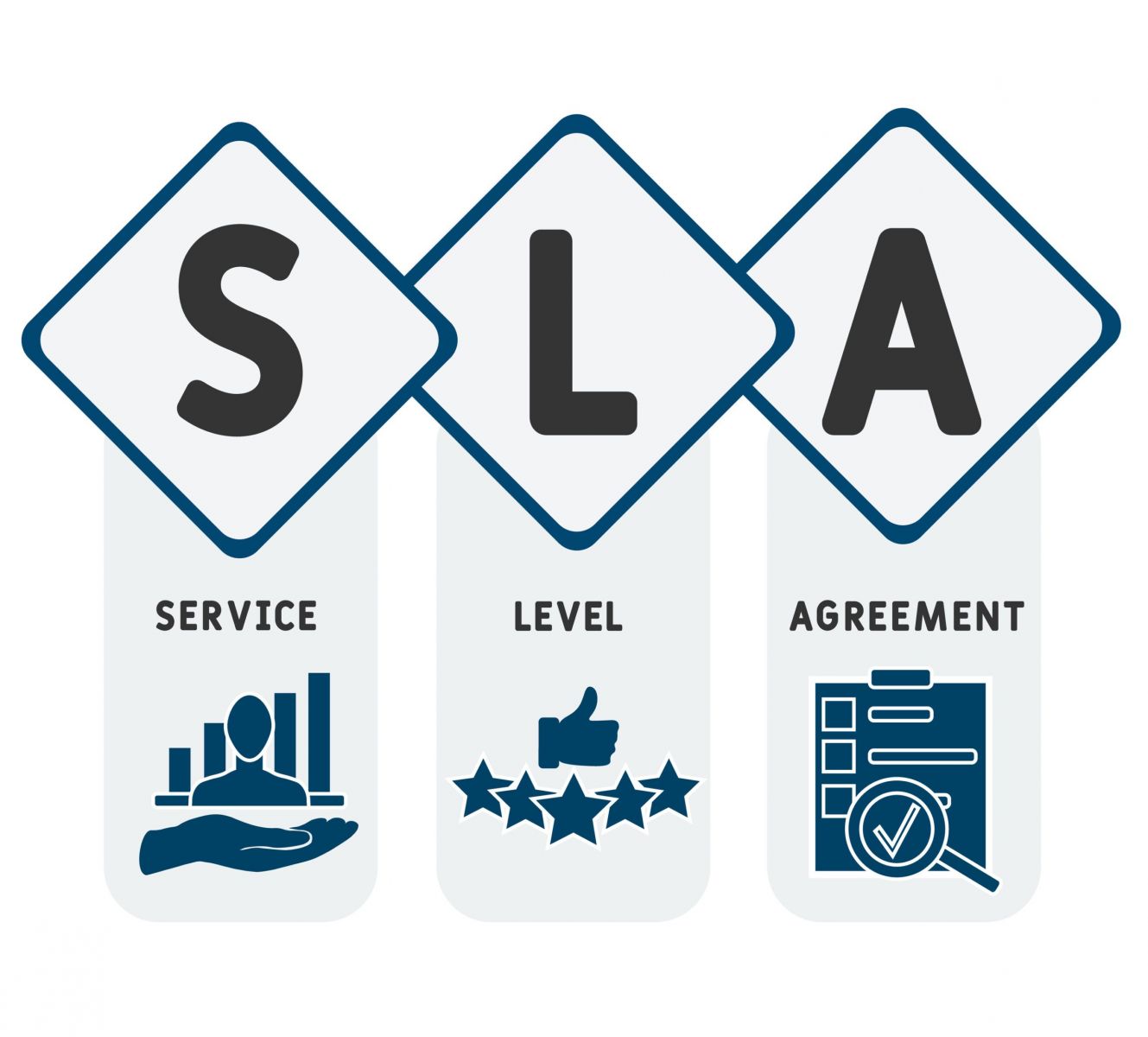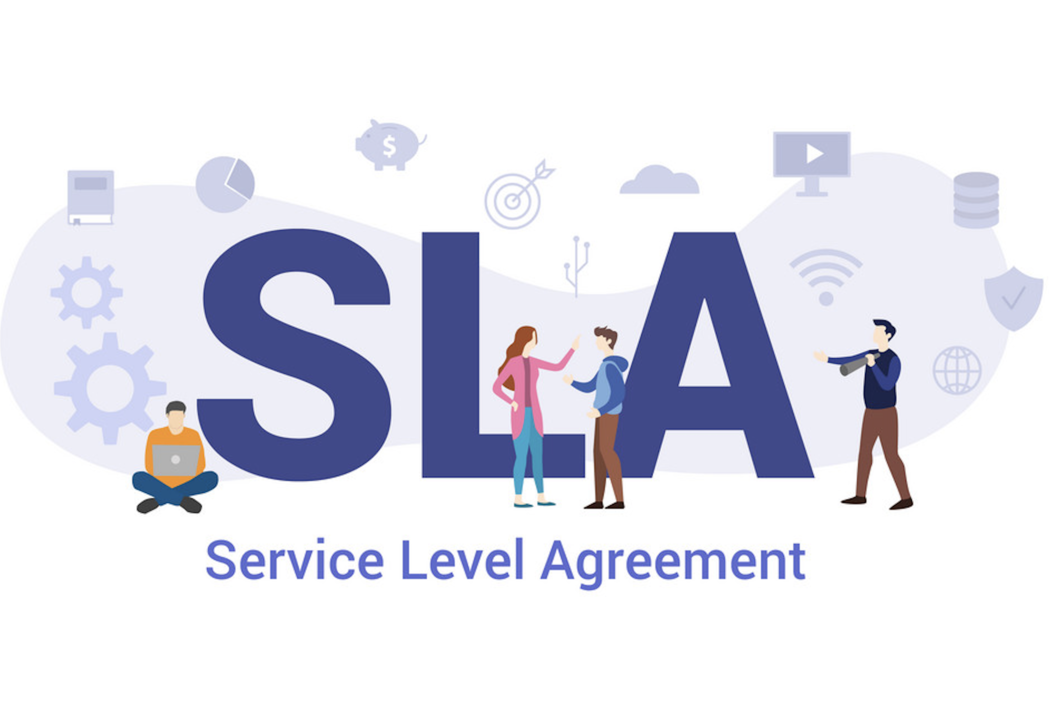What is an SLA?
SLA stands for Service Level Agreement. Often used with outsourced services, it aims to define standards for the offer, goals, contractual issues, support, and whatever else applies to the offered services.
Therefore, the SLA is a complex document that companies need to review periodically to ensure it is updated.
Why is it important to have an SLA?
The SLA guarantees the provider and the client compliance with the agreed services. This document lists all the obligations of both parties during the business relationship.
Thus, if any conflict or disagreement occurs, the SLA’s norms clarify what must or not be complied with. If there is any non-compliance in what was agreed, it is necessary to apply fines to compensate the party that will not receive what the SLA has established.
What are the differences between SLA and KPI?
It is common for some people to mix SLA and KPI, but they are two very different concepts. In short, companies build an SLA to ensure complying services until the end of the contract. KPIs, on the other hand, are performance indicators aimed at measuring actions already taken.
Thus, the SLA anticipates what may happen and tries to ensure that everything goes well, while the KPI brings predefined indicators to measure the results of the actions put into practice.
What are examples of SLA?
The SLA can be signed either between your business and a third-party company or between you and an employee. To make this clear, let’s consider two examples.
Regarding your employees, you should sign this contract internally. This way, you are able to determine all the services the worker will perform during working hours. Then both of you are sure about the established duties.
The same applies if your company hires a company to outsource a service. Before signing the contract, it is essential to read it and ensure that all the terms and clauses meet your needs.
What are the SLA types?
Basically, there are two types of SLA: customer-focused and service-focused.
Customer-focused
This type of SLA focuses on organizing the client’s obligations and expectations about the contract. It has a more specific approach and its execution may be more complex since each client has a different SLA.
In case you offer services, this option may not be the most recommended. However, if you decide to do it anyway, you should pay attention to contractual changes: each amendment must be inserted in the contract signed by both parties.

Service-focused
This format is simpler, as it is dedicated to the provided services, so you can use it both for internal contracting and for your services to clients.
However, when adopting a service-focused SLA, addition of specific items in each contract is not allowed. Thus, the parties must read the agreement and be aware of their obligations when they sign it.
How to ensure a better understanding of the agreement?
Your company needs to identify the risks that are likely to happen when developing an SLA. This way, you can reduce their magnitude, especially regarding the service delivery and respective deadline.
For this to happen, both parties involved need to be aware of their obligations. It is recommended to discuss the important points in order to make sure that all elements of the contract has been understood.
Also, when someone from your sales team draws a business proposal for a client, it is essential to present it rather than send it by email. This action strengthens the contractual bond between the two sides.
How to develop an SLA?
To develop the SLA, it is necessary to consider the following points:
- objectives that the service is supposed to achieve;
- performance of all those involved in this work;
- standards followed by the company that must serve as the basis for an SLA;
- specific metrics;
- timeframe for meeting the established deadlines.
Once the above points are defined, follow the steps below.
Step 1: Define a baseline
Start by looking at how your current SLAs are. Even if you have not documented them, you need to check if the methodology aligns with your set goals.
Step 2: Check the work routine of the involved parties
You need to check everyone’s work routine to know if the documented service applies to all. To do this, talk to the team to ensure everyone can adequately dedicate to the services established by the SLA.
Step 3: Only consider what is necessary
Also, identify which tasks are unnecessary in the service delivery. This will help all parties to manage their working time since they don’t need to focus on non-essential actions.
Step 4: Define each party’s responsibilities
First, it is necessary to have a clear statement of each party’s obligations. It is essential to communicate and emphasize this throughout the contract period.
Determining what does not meet the contract is also important when drafting the SLA. This action avoids misunderstandings regarding the activities that the company will be performing.
Step 5: Determine the requirements
Defining the requirements is also essential in the SLA development, as it clarifies what services you will be providing.
To do this, determine which goals the team must achieve when providing services. Your main basis must be the standards your company follows, as this prevents misalignment among those involved.
Also, if internal or external factors interfere with the agreed services, having these points predefined helps to avoid possible losses.
Step 6: Set deadlines and sanctions for non-compliance
Once you have developed the SLA, you also need to establish deadlines and penalties in case of non-compliance. This action is essential to optimize the execution of contracted services and adapt them to routine.
Deadlines are even more helpful when it comes to services that will be performed in a short time. For example, when implementing a management system, the execution period is likely to be short, so it is necessary to set deadlines for the activity to start and end.
Step 7: Consider the capabilities of your IT team or manager
Before hiring a service that requires your IT team or a person’s dedication, consider their technical capabilities to avoid demanding something they don’t know how to handle yet.
So, when hiring the service internally, make sure your IT can do what you need. If not, you should outsource the service and ask your IT staff to monitor the work.
Step 8: Create result indicators
KPIs are of utmost importance to know if your team is performing well the actions presented in the SLA. Therefore, you must define these KPIs in advance to measure the services’ performance. This allows you to check if they are performing as expected or if you need to make adjustments.
To make changes, both parties need to be aware and in agreement in order to avoid any problem. Also, you can adapt the execution to attend service requirements.
What are the best SLA practices?
After developing an SLA, you must follow some practices to implement it correctly. Here are the main ones.
Set an average response time for problem-solving
When a client calls your business because of a problem, the teams in charge need to perform a quick response time. After all, the longer the problem persists, the bigger the delays and damages to work.
Therefore, when defining your SLA, consider potential problems and the average time it takes to solve them. This way, everyone will have the right expectation about response time.
Use neutral language between the parties
It is important to use terms that are clear and simple for everyone to understand. Even if you are able to understand what your IT manager says, particular words may be difficult to understand for your clients and even colleagues at the company. In this context, neutral language is key to ease communication.
Simplify the creation of SLAs
Instead of creating long and complex SLAs, set simple and shorter versions, so you can analyze their flow and the customer can understand them. This action makes the workflow more appropriate to optimize each task your team must do.
Define which tickets have higher priority
Imagine that, during a work shift, one of the headsets stops working in an important call and the CRM access goes down. Your IT manager will receive two tickets at the same time. So which one to prioritize?
Answering this question requires you to define the different ticket priorities in advance, as the weight can be higher or lower depending on the circumstance.
In the example above, access to the CRM would be a higher priority because it affects everyone’s work, while the damaged headset concerns only one person. However, if the call is to talk to a customer who is about to churn, that priority might be higher.
Determine days and times for SLA tasks
A customer may get frustrated when they contact you and do not get a response. But what if they made contact on a Saturday midnight instead of Monday through Friday business hours?
If your company operates Monday through Friday during business hours, it has to be clear in the SLA. This way, customers are aware that your team will only perform tasks and requests during the given days and times.
On the other hand, if the service is outsourced and provides 24/7 support, it is still essential to insert in the contract what types of services are provided during and outside business hours. This way, customers and everyone inside the company know what to expect.
What are the benefits of creating an SLA?
To help you know the benefits of an SLA, we have listed the most important ones below.
Improved communication
A smooth communication between the two parties of a contract is essential. This is why the SLA is so important in this regard. After all, it states clearly all the terms of service.
Retention
Suppose you have ever had to change employees in any area of your business. Then you know that it is difficult to establish a long-term professional relationship, right? The same goes for your clients. But don’t worry because this problem affects many other companies as well.
That is why a well-structured SLA is effective in building loyalty. Since both parties know the obligations they need to meet, trust is increased.
Improved service
Hired services become more organized after the elaboration of an SLA because they start to follow a standardization. All parties involved in the contract know precisely what to provide, which increases productivity and service efficiency.

Flexibility
Standard contracts usually have inflexible terms. So any change requires a new term to be added, making the process not so simple.
The SLA is simpler because you can edit it whenever necessary, as long as the parties involved are in agreement.
How to measure an SLA?
SLA measurement varies from one company to another, as it depends on the services they offer. Thus, it is necessary to monitor many points within an SLA; and you need to do it the best way.
It is important to measure the SLA with similar methods to those you already use. This action makes everything more understandable. Here we point out the types of SLA measurement that are commonly used to make this even clearer.
Service availability
As we said, you can provide the services within business hours (if these are your company’s standard hours) or 24 hours a day (which usually applies to external hires). Therefore, you must measure the service availability.
Businesses that offer online solutions or e-commerce products, for example, need to have stricter SLAs. The reason is that if the virtual store is offline on the weekend, this causes a huge loss that you must measure at the end of the month.
SLA problems
Yes, you do need to consider any problem when measuring. By analyzing the setbacks that happened, you can draw up an action plan to make your actions more effective.
Therefore, try to find out what are the main problems that occur during the tasks that belong to your company’s SLA, such as:
- backups on your site or system;
- coding errors;
- reworks;
- missed deadlines;
- device defects.
You must apply this measurement to services done both internally and for your clients.
Consider that you must meet the customer’s objectives through the SLA-established tasks. Besides, you must also measure the applied quality. It ensures a high quality of work.
Security
Your company information and client database are essential for the business structure. Can you imagine if a hacker had access to them?
To prevent this from happening, make sure the SLA has security measures, as well as a structure you can use to track and measure it.
Results
Your business develops an SLA to achieve goals, so results should also be measured. You need to break down goals into targets, so each of the parties involved in the services is guided to meet them.
Goals can be daily, weekly, biweekly, monthly or even quarterly. It is essential to keep track of them to make sure that you are on the right way.
By following these guidelines, you will be able to measure your company’s SLAs. The work is not entirely your responsibility, so all your staff must do some self-management.












Replies to This Discussion